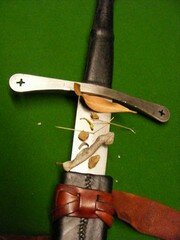Renaissance wax restoration:
Has your longsword been given the short shrift
to rust in peace in the back shed?
Yes, I do realise a longsword is not Chinese.... so what's it doing in the Chinese Swords Guide?
The day will come; it is almost upon us, when the revival of Historical Chinese Swordsmanship is developed enough for us all to need blunt steel Chinese swords and real armour for our training. I want to be the first to tell you how to care for Chinese reenactment weapons and armour. So let's get out the sandpaper and Renaissance Wax, and derust the trusty reenactment blade before it disolves into splinters of flakey red landfill.
You DIDN'T put it in the scabbard like THAT!
 |
This is the preventative note, if it isn't already too late....
Don't put a dirty sword in a scabbard. The dirt will stick to the inside of the scabbard and scratch your blade.
Perhaps that doesn't matter for a full contact steel on steel reenactment sword....
Okay then, what about having so much gunk in there you can't pull it out! Right, clean it up then.
By the way, if you want great ready made reenactment gear, take a look at gkswidgets com. They have medieval clothing, accessories, swords, armour and everything else you need. They even have collector models.
Renaissance Wax and sandpaper.
 |
I figured that if it was that good, I'd use it on all my reenactment steel. I won't be putting it on my nicely etched antique jian, but every day user weapons and armour need something easy and reliable. Reach for the sandpaper and Renaissance Wax. Remove rust while you still have a blade.
How to clean up a sword when it's already too late.
You will need:- Sandpaper in various grits from 150 - 600
- A sanding block
- Methylated spirits
- clean rags
- Several patient hours
Use a heavy grade of sandpaper - perhaps 150 grit if the blade is in a real mess. Stroke down the blade until most of the heaviest rust is removed. This will leave scratches on the steel as well as cleaning off the rust. Then take the next grade of sandpaper - 250 grit, and stroke across the blade until the rest of the obvious rust is removed and the scratches down the blade have all been removed.
You now have an almost rustless blade with smaller scratches going across the blade but no deep ones going down. Keep using the sandpaper in progressively higher grit numbers. Alternate stroke directions with down and across. The higher the number on the paper, the finer the grade. The reason for alternating stroke direction with the next level up is to remove the previous scratches until the grade is fine enough for it not to matter.
When you get to about 500-600 grit, stop. Your reenactment blade is going to get scratched up again the next time Lord Whatsy Von Whodayacallum, wallops into you with cross strikes and goes vom tag zum fool and you have to deflect or die. But that's no excuse to let the sword go rusty. Scratches are normal. Rust is disgusting.
When the blade is clean and as shiny as the day it was forged, clean it off with methylated spirits and a soft rag. let it dry. Put a small amount of Renaissance wax on a soft cloth, and rub it all over the steel. Don't make it too thick, or that will gunk up your scabbard as well.
Leave the wax to set a bit and then take another soft cloth and polish it. It's as easy as that. Your reenactment sword has a silver blade instead of a red one. You won't have to rewax it every time you touch it. Renaissance Wax is the most practical modern solution I've found for swords that are touched often and used against steel.
Finding equipment
It's easy to get Renaissance wax. It's used for preserving things in museums, not just reenactment swords. Type it into your search browser and you'll find it.Sandpaper in various grits can be obtained from big hardware stores, specialist woodworking suppliers, or (where I got mine) specialist car shops. They use it for detailing and polishing paint jobs. This is where you will find the finest grades if you want to highly polish a collection sword.
Methylated spirits - any hardware store or department store.
Swords For Sale
 Want to buy a
Want to buy afull tang sword?
Traditional Qing Dynasty design by Scott M. Rodell, made for Test Cutting!
SMR Hanwei Chinese Cutting Sword
Click anywhere in this box
 Affordable full tang
Affordable full tangDao for sale?
Great quality cutting dao to suit your budget.
Click anywhere in this box
Sword For Sale

VIKING SWORD FOR SALE
This sword is used but in excellent condition. Del Tin forged full-tang blade, peened pommel, lambswool lined wood scabbard with hand-sewn leather outer.
$400 PLUS POSTAGE
Click here to contact Linda for more information or pictures.






































